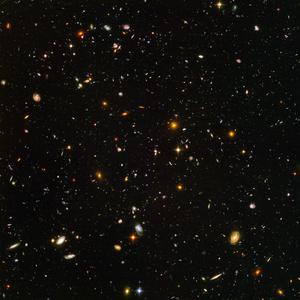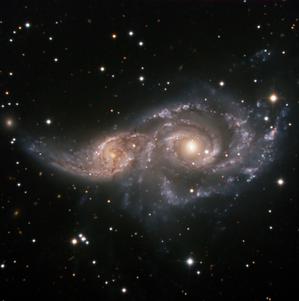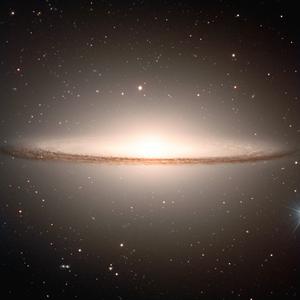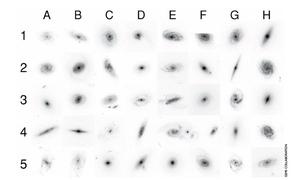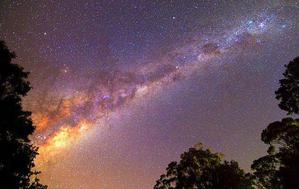Glossary term: Galaxie
Description: Une galaxie est un système d'étoiles, pourvu de divers éléments matériels tels que la matière noire, le gaz et la poussière, liés par la gravitation et généralement séparés de leurs voisins par des centaines de milliers d'années-lumière. Les galaxies se présentent sous différentes formes et tailles. Les plus petites galaxies peuvent contenir quelques milliers d'étoiles, tandis que les plus grandes peuvent en contenir des dizaines de milliers. La formulation " La Galaxie " avec une majuscule fait généralement référence à notre galaxie d'origine, la Voie Lactée, qui compte entre 100 et 400 milliards d'étoiles.
Related Terms:
- Matière noire
- Galaxie à disque
- Poussière
- Galaxie naine
- Galaxie elliptique
- Bulbe galactique
- Centre galactique
- Disque galactique
- Halo galactique
- Amas de galaxies
- Gaz
- Greenwich Mean Time Zone (GMT)
- Galaxie irrégulière
- Voie lactée
- Spiral Galaxy
- Étoile
- Barre galactique
- Galaxie lenticulaire
See this term in other languages
Term and definition status: The original definition of this term in English have been approved by a research astronomer and a teacher The translation of this term and its definition is still awaiting approval
The OAE Multilingual Glossary is a project of the IAU Office of Astronomy for Education (OAE) in collaboration with the IAU Office of Astronomy Outreach (OAO). The terms and definitions were chosen, written and reviewed by a collective effort from the OAE, the OAE Centers and Nodes, the OAE National Astronomy Education Coordinators (NAECs) and other volunteers. You can find a full list of credits here. All glossary terms and their definitions are released under a Creative Commons CC BY-4.0 license and should be credited to "IAU OAE".
If you notice a factual or translation error in this glossary term or definition then please get in touch.
Related Media
Hubble Ultra Deep Field
Credit: NASA, ESA, and S. Beckwith (STScI) and the HUDF Team credit link
License: CC-BY-4.0 Creative Commons Attribution 4.0 International (CC BY 4.0) icons
Fusion de galaxies spirales
Credit: ESO credit link
License: CC-BY-4.0 Creative Commons Attribution 4.0 International (CC BY 4.0) icons
Sombrero galaxy
Credit: ESO/P. Barthel credit link
License: CC-BY-4.0 Creative Commons Attribution 4.0 International (CC BY 4.0) icons
Related Diagrams
Leo Constellation Map
Credit: Adapted by the IAU Office of Astronomy for Education from the original by IAU/Sky & Telescope
License: CC-BY-4.0 Creative Commons Attribution 4.0 International (CC BY 4.0) icons
Related Activities
Glitter Your Milky Way
astroEDU educational activity (links to astroEDU website) Description: Explore the Milky Way and characteristics of galaxies using glitter drawing.
License: CC-BY-4.0 Creative Commons Attribution 4.0 International (CC BY 4.0) icons
Tags:
Art
, Creativity
, Hands-on
, Handcraft
Age Ranges:
6-8
, 8-10
Education Level:
Middle School
, Primary
Areas of Learning:
Fine Art focussed
Costs:
Medium Cost
Group Size:
Group
Skills:
Communicating information
Coma Cluster of Galaxies
astroEDU educational activity (links to astroEDU website) Description: The basics of galaxy classification, using Hubble Space Telescope images.
License: CC-BY-4.0 Creative Commons Attribution 4.0 International (CC BY 4.0) icons
Tags:
Coma Cluster
Age Ranges:
14-16
, 16-19
, 19+
Education Level:
Secondary
, University
Areas of Learning:
Guided-discovery learning
Costs:
Low Cost
Duration:
1 hour
Group Size:
Group
Skills:
Analysing and interpreting data
, Communicating information
, Constructing explanations
, Planning and carrying out investigations
Living in the Milky Way
astroEDU educational activity (links to astroEDU website) Description: Build a model of the Milky Way to discover what our galaxy contains.
License: CC-BY-4.0 Creative Commons Attribution 4.0 International (CC BY 4.0) icons
Tags:
Hands-on
, Model
Age Ranges:
6-8
, 8-10
Education Level:
Primary
Areas of Learning:
Problem-solving
, Social Research
Costs:
Medium Cost
Duration:
1 hour 30 mins
Group Size:
Group
Skills:
Asking questions
, Communicating information
, Developing and using models
